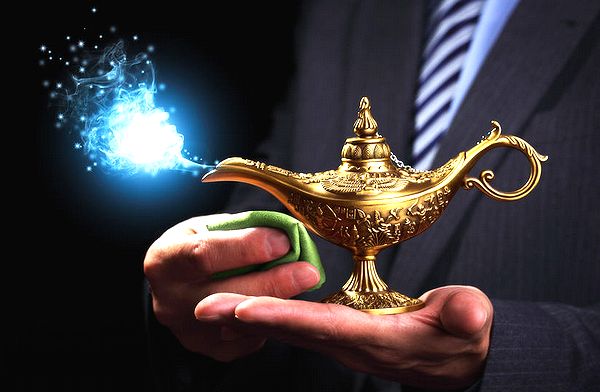The Western concept of genie comes from the tale of Aladdin in the Arabian Nights. Aladdin frees a genie from his imprisonment in a lamp, who then grants wishes in return. The unintended consequences are expressed in the adage, “Be careful what you wish for.”
Getting our genies right.
First off, “genie” is not “Jeannie.” I Dream of Jeannie was a sitcom that aired from 1965-70. The show starred Barbara Eden as a 2,000-year-old genie, and Larry Hagman as an astronaut who becomes her master. Wearing her trademark “Jeannie Costume,” Eden’s navel was glimpsed in a few of the later episodes, much to the dislike of the censors.
Flying carpets (and notable navels) aside, we have another genie. More precisely, an Italian statistician named Corrado Gini, who in 1912, devised the “Gini coefficient” (or “Gini” for short). Widely used by economists, Gini is the classic tool for measuring income inequality: the gap between what the richest people in the country earn and what the rest of us earn. What made Gini’s work important—and his coefficient still relevant 100 years later—is that in principle it summarizes all the information about the distribution of income and thus facilitates easy comparisons. This is why politicians love it.
Mind the gap.
The U.S. Census Bureau (2013) has been using Gini’s measurement to calculate income inequality in America since 1947. Overlooking the math, Gini is a number that ranges from 0 (everyone has the same income) to 1.0 (one person has all the income). Thus, a higher Gini means that the wealthier are getting wealthier, or the poor are falling behind, or both.
Between 1947 and 1968, the overall U.S. Gini dropped to 0.39, the lowest ever recorded. Since then, the Gini has risen steadily to 0.48 in 2014 (Ginis are also tabulated for the 50 states—check out yours here). While this means that inequality has been rising, most of the increase was due to enormous growth in income for the richest 0.1 percent of Americans. You won’t see these people dining at Denny’s, IHOP, or Ponderosa Steakhouse.
Lies, damned lies, and statistics.
Ginis can be fickle. For households and families, the index has steadily risen since 1970. But for individuals, the Gini has been essentially flat since 1960. Since income is paid to individuals, not to households and families, this presents a paradox. Some economists conclude that social factors, such as the changing composition of the nation’s families and households over time, are the primary drivers of that trend. Of course, politicians read what they will into these ambiguities.
 In addition, the Gini coefficient is not a perfect measure of inequality. It considers only cash income and doesn’t subtract taxes (most of which are paid by the wealthy). It excludes non-cash transfers that benefit low-income earning earners such as housing and nutritional assistance, Medicare, Medicaid, and earned income tax credits. It also ignores other forms of income that predominantly benefit the well-off, such as capital gains, employer-provided retirement benefits, and health insurance (see: We are the 99%).
In addition, the Gini coefficient is not a perfect measure of inequality. It considers only cash income and doesn’t subtract taxes (most of which are paid by the wealthy). It excludes non-cash transfers that benefit low-income earning earners such as housing and nutritional assistance, Medicare, Medicaid, and earned income tax credits. It also ignores other forms of income that predominantly benefit the well-off, such as capital gains, employer-provided retirement benefits, and health insurance (see: We are the 99%).
Finally, compared to other countries, the U.S. has one of the most unequal income distributions in the developed world, according to the Organization for Economic Cooperation and Development. In 2010, the U.S. index was 0.47, compared to a 0.31 average for 27 European Union nations. But numbers don’t tell us about living standards, and after adjustments we don’t fare as badly as advertised.
Despite its shortcomings, the index remains the most commonly used measure of inequality. Nevertheless, the index is best used in conjunction with other approaches that show how the distribution of income among various groups is changing over time.
Wake up and smell the hummus.
Come election time, you’ll hear politically motivated rhetoric about income inequality, citing the Gini coefficient as gospel. As a certified smart person, you are not that naive. So, what’s a young person to do? Be informed about the issues and resist animus based on simplistic clichés such as “the evil 1 percent” or “47% of Americans are dependent upon government.” Better to ask, “What is the genie promising today?”
Oooh! Money! Royalty! Fame! Why didn’t I think of that? Okay, you asked for it! A hundred servants and a hundred camels loaded with gold! Just say the word and I’ll deliver it in 30 minutes or less, or your meal’s free. Hey, I’ll even throw in a cappuccino!
~ Genie of the lamp (Kingdom Hearts)
Learn more about this, and other interesting topics, in the Young Person’s Guide to Wisdom, Power, and Life Success.
Image credit: “Businessman holding and rubbing a magic Aladdins genie lamp” by Brian Jackson, licensed from 123rf.com (2015).




















